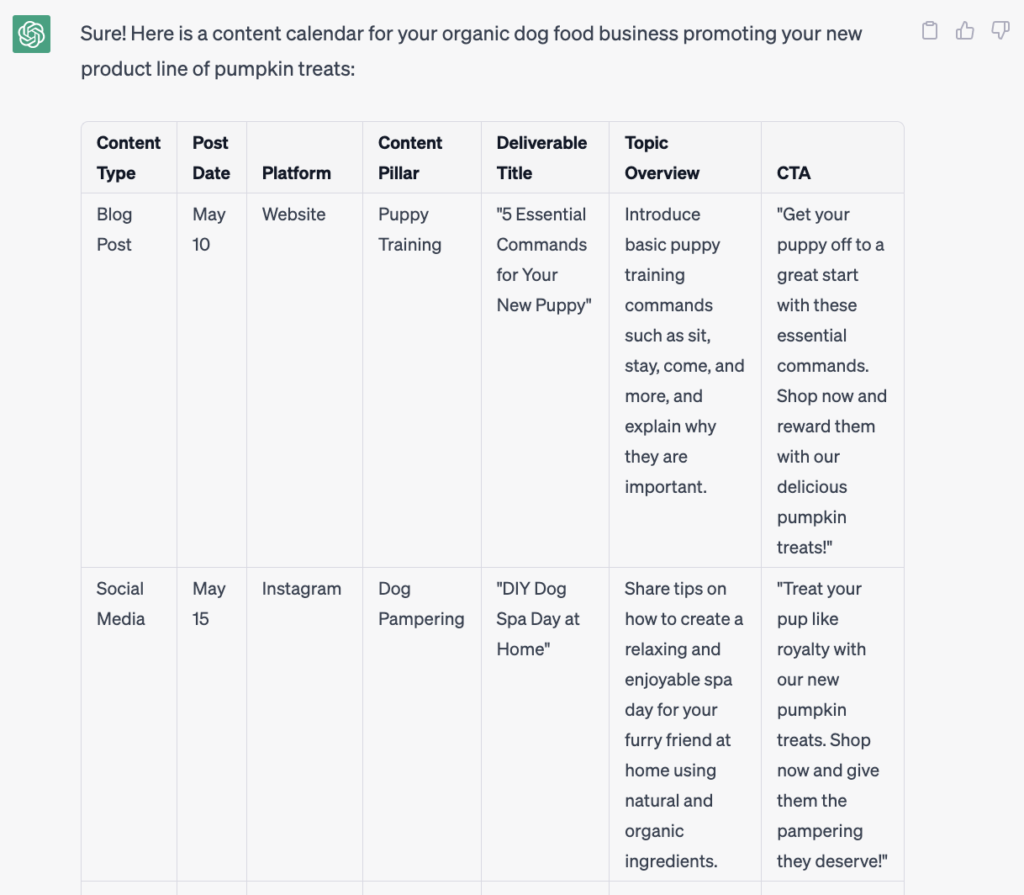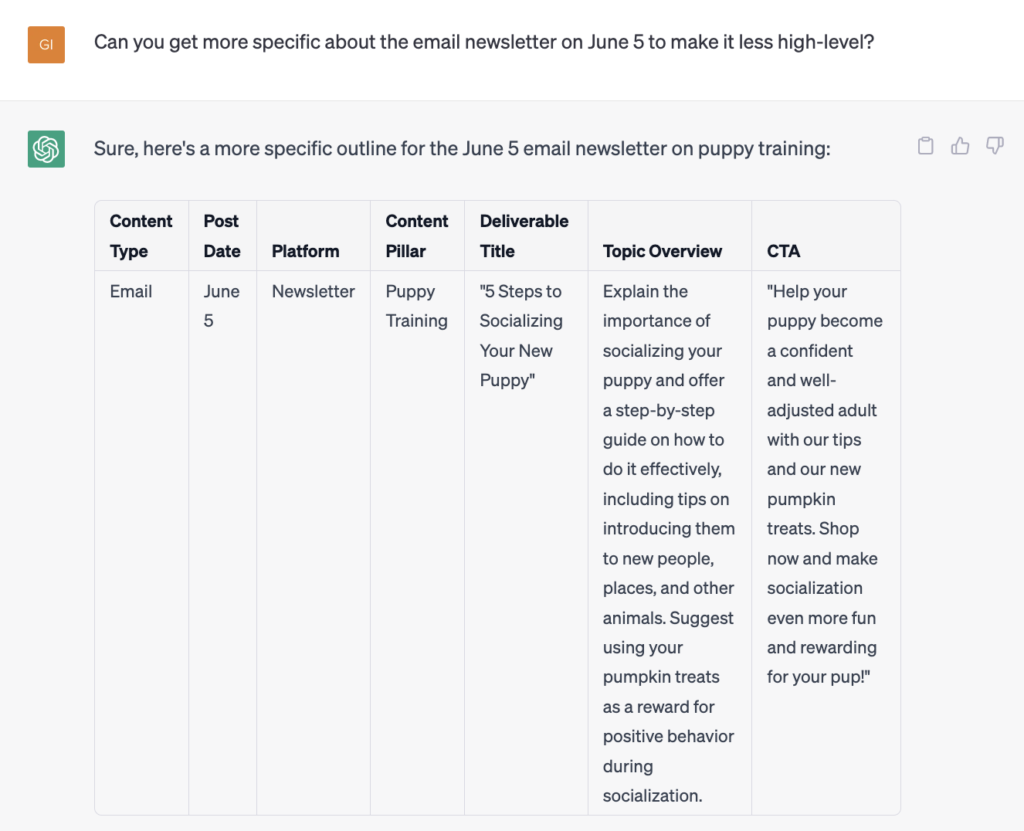By Brooke Gocklin for Contently
We’ve all seen the headlines: “Yes, ChatGPT is coming for your office job,” “How language AI could revolutionize marketing,” and even “Engineers added ChatGPT to a robot dog and now it can talk.”
Whether you’re feeling cautious or excited about the AI revolution, one thing’s undeniable: If you’re not leveraging technology like ChatGPT to work smarter, not harder, you’re missing out.
One way ChatGPT can power your work in content marketing? The content calendar creation process.
In this post, we’ll dive into what is ChatGPT and, more importantly, how to get started, so you can become a prompt-writing whiz.
But First, What Is ChatGPT?
Built by OpenAI, ChatGPT is a language model that has been trained on a massive amount of text data and can subsequently create human-like text, understand the context of natural language, analyze sentiment, provide suggestions for completing sentences, and — you guessed it — generate ideas for a content marketing calendar.

Why Should You Use ChatGPT for Content Calendar Creation?
Modern content marketing is a complex endeavor that involves strategy, SEO, creativity, wordsmithing, and oh-so-much organization.
Enter the content calendar: Whether you’re publishing one blog a month or juggling a massive content marketing engine comprising ebooks, blogs, infographics, and worksheets, a content calendar is essential for keeping you and your team aligned, productive, and sane.
That’s why using tools like ChatGPT to turbocharge the content calendar creation process is a no-brainer. You can:
- Save time. Tired of long awkward silences in your monthly topic ideation meeting? Just input your content marketing strategy, goals, and target audience into ChatGPT, and it’ll instantly generate quick ideas that your team can expand upon.
- Increase efficiency. Instead of manually managing publishing schedules to ensure no content gaps, ChatGPT can develop a clear roadmap that supports more effective work.
- Improve your content quality. No matter how many news articles, pop culture podcasts, or trending TikToks you consume, you can’t compete with ChatGPT on data quantity. Given the trove of information it’s been trained on, ChatGPT can suggest relevant topics and themes you may not have previously considered.
The result? A content calendar that is more engaging, valuable, and relevant, leading to increased engagement and conversions. Plus, you’ll also have more time to focus on other essential aspects of your business — what’s not to love about that?
I’m Sold! How Do I Get Started With ChatGPT for Content Calendar Creation?
Step 1: Define your goals.
The key to any content marketing strategy that doesn’t simply rehash existing content is having clear goals tailored to your business and target audience.
So, ask yourself: What do you want to achieve with your content? Are you looking to increase brand awareness, generate leads, or drive conversions? Do you want to entertain, inform, or persuade?
Step 2: Identify your audience.
Next, identify your audience to ensure the content that you create resonates. What are their interests, pain points, and needs? What content format do they prefer — extensive ebooks, short blogs, videos, or listicles?
Step 3: Determine your content themes.
Now, it’s time to determine your overarching content themes. What core topics is your audience attracted to? How do they align with your content marketing goals? Ideally, you’ll want to generate three or four core content themes.
Step 4: Input data into ChatGPT.
You’re finally ready to head over to ChatGPT. Once you create an account and log in, provide ChatGPT with all the information you’ve compiled above, then ask it to generate a content calendar.
HERE’S A PROMPT TO GET YOU STARTED:
“Create a content calendar as a table for my “description of what you do” business. The aim is to “summary of content goals” to “summary of audience”, and my content themes are: “content pillars”. Include columns for Content Type, Post Date, Platform, Content Pillar, Deliverable Title, Topic Overview, and CTA.”

Step 5: Review and refine the output.
If ChatGPT didn’t hit the mark on the first try, don’t panic. The beauty of this tool is that it retains information for every session, meaning you can easily review and refine elements, such as your ideal posting cadence and content formats, to your liking.

3 Tips for Maximizing ChatGPT for Content Calendar Creation
There’s a reason companies are offering AI prompt engineers a whopping $335,000 in compensation — while the answer to “What is ChatGPT?” is straightforward, getting high-quality results requires a mix of creativity, strategy, and understanding of how AI chatbots work.
That said, here are three tips to help you get the most out of ChatGPT — and ensure you’re using it responsibly.
1. Provide clear and specific inputs.
Contrary to what some have claimed, AI chatbots are, indeed, not sentient. That’s why the more information you provide, especially around your goals, audience, and content themes, the better the output will be.
2. Refine outputs by diving deeper.
Content that ChatGPT generates on the first try tends to be pretty high-level, so don’t be afraid to ask it to get more specific. After all, the last thing you want is to waste time creating vague content that doesn’t offer anything new.

3. Don’t rely solely on ChatGPT.
While ChatGPT can be a helpful tool for generating ideas and streamlining the content calendar creation process, it doesn’t have the same insider knowledge of your business as you and your team.
So, use it as a starting point for your content calendar, but personalize outputs with your own judgment, tone and voice, and creative juices. You’ll also want to do a quick fact check: ChatGPT may confidently spout inaccuracies — it’s simply a language model, after all.
Your AI-Powered Content Calendar Awaits
Creating an engaging and compelling content calendar doesn’t have to be a painful or time-sucking task, especially when armed with an AI chatbot like ChatGPT.
But remember: ChatGPT is simply a tool and not a replacement for human talent — its power lies in how you use it. So, make sure you’re always adding that human touch to spice up any content ChatGPT generates, and when in doubt, defer to the expertise of seasoned content marketers.
